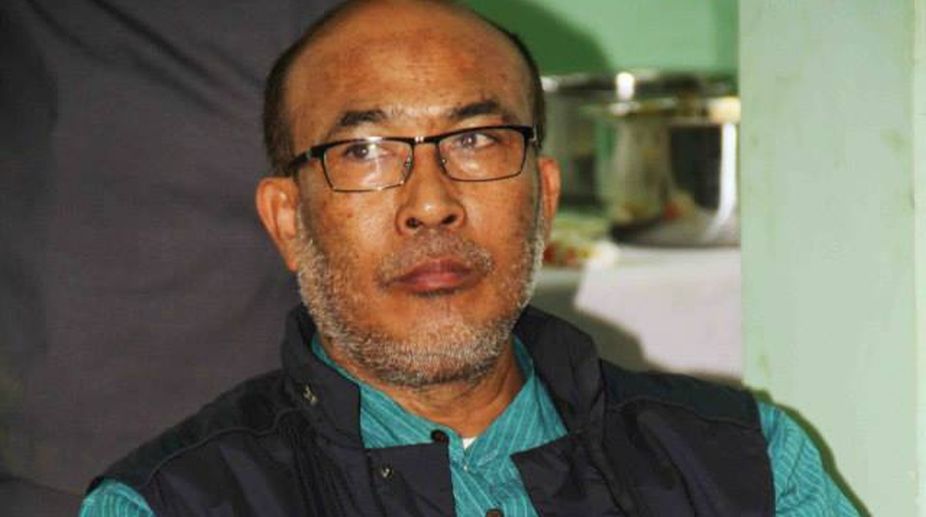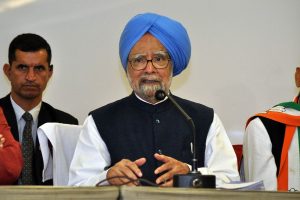It would seem that politicians and gaffes are inseparable going by Manipur chief minister Thongombom Biren Singh’s speech at Madhavpur, near Porbandar in Gujarat. It had the trappings of a neo-convert to the Hindutva-fold paying obeisance to his “messiah” and Prime Minister Narendra Modi.
For the record, at the end of last month the chief minister was in Gujarat where a local festival was being held to mark the marriage of Lord Krishna with Rukmini, supposedly a princess of Arunachal Pradesh’s Idu-Mishmi tribe, and for the first time in his political career, he spoke in Hindi. What he had to say evoked laughter from some quarters and intense resentment from the bulk of the Manipuris in his state and elsewhere.
Advertisement
It became a mega event for not only the Indianisation of the North-east, but completing the saffronisation of the region where today the BJP is in power in five of the eight states. Singh went overboard in his interpretation of a mainland Hindu mythological tale that had a lot of political undercurrents. For instance, he said that 5,000 years ago Lord Krishna had united the North-eastern region with mainland India at a time when there was no Assam. Manipur nor Nagaland and the entire region was one entity.
His remarks were echoed by Arunachal chief minister Pema Khandu, who said that “nobody can change this historical fact, apparently taking a dig at China’s claim to some parts of his state. Gujarat Governor Brig (retired) BD Mishra said that if 5,000 years ago an Arunachal princess could travel 3,500 km and become queen it signified that Arunachal (until 1972 known as North East Frontier Agency) , had always been part of India and will continue to be so.
He also said that marriages had been an important part of India’s territorial integrity. The Madhavpur fair was not merely a religious but also an event of cultural unity and one which underlined unity in diversity. Gujarat chief minister Vijay Rupani took a dig at various insurgent groups in the North-east fighting for independent states. He said it was not that these states became parts of India after Independence. The Lord Krishna-Rukmini marriage at Madhavpur underlined that India was one since those times, he added.
All these leaders seem to have forgotten that India is an ancient land and became a young nation after Independence. Prior to this the country was ruled first by the Mughals and was later consolidated by the British. Later Sardar Vallabbahi Patel gave the finishing touches by annexing princely states, thus consolidating the remnants of British India.
History seems to have undermined the fact the North-east has been in turmoil for the last 60 years of its association with mainland India. For instance, it was Angami Zapu Phizo who, like Sheikh Abdullah of Kashmir, had questioned the concept of Indian nationhood. Phizo had simply told the British that “you were the first to conquer us (Naga Hills of Assam then) and so when you leave us do not leave us with anyone, but leave us alone”.
That ignited the flames of the Naga nationalism in 1947, followed by hostile activities in the mid-1950’s and it is still continuing with no plausible solution in sight except for the one much-debated “framework agreement” signed on 3 August 2015 with the NSCN (IM) leadership. (It is neither here nor there because its contents are yet to be made public)
The United Liberation Front of Assam, for instance, contends that the British took over Assam after the end of the Burmese occupation and that the government of India had no locus standi over making Assam a part of India. With this basic viewpoint Ulfa’s self-styled commander-in-.chief Paresh Barua, is still waging a war with India while most of his colleagues returned and are in peace talks with the Centre.
In Manipur, the Meities are proud of having a history of 2,000 years and that they had fought the British in 1891 following which Manipur lost her sovereignty as between August 1947 to 1949, no India Tri-colour had not flown in the state. For the first time the flag was hoisted after then Maharaja Budhachandra was kept in captivity by then Assam Governor and made to sign under duress the “merger agreement “on 21 September, 1949. The take-over was completed on 15 October the same year. Various Meitei rebel groups still observe this as a “Black Day.”
On 1964, the National Liberation Front of Manipur was born. It questioned the legitimacy of the merger agreement. Although its former chairman RK Meghen is now serving a 10-year jail term in Guwahati after his arrest in Dhaka by Indian agents in 2010, the outfit is still a force to reckon with.
Also forgotten is the fact that Manipuris had been converted to Hinduism by a Bengali Hindu missionary called Santi Das Gosai, some 400 years ago. Biren Singh also seems to have forgotten what he had said at a discourse at Barapani, near Shillong in 2000. He was quoted then as having said that it was the advent of Hinduism that had fomented the great tribal-non-tribal rift in Manipur falling short of just condemning the conversion.
All that was required for him to say was that Hindu Manipuris consider Manipur to be the land of Govindaji (Krishna) and that the Manipur war-cry, when it went to war against the British in 1891, was “Govindaji na joy oire” — meaning victory to Govindajee.
But Biren Singh’s political adviser from the mainland drawn from RSS ranks must have nudged him into making the political statement based on Hindu mythology.
Pema Khandu also seems to have no local knowledge of his own constituency of Tawang.- It was under Tibetan suzereignty till 1952 and that the famed Tawang monastery was under the Tibetan Dzongpens (magistrates) administering the area all the way up to Dirang-Dzong, till 1952.
That was when an Indian expedition team led by Manipur’s Major Bob Khating fixed boundary pillars at Bumla, asserting that south of it was Indian territory. That the Chinese withdrew to the north of Bumla in 1962 can at best be looked at as a generous act. Also what seems to have been forgotten was the existence of an ancient kingdom called Kamrupa, now Assam. The Madahvpur incident went viral on the social media. It showed Singh speaking in Hindi saying “hum to ladki wale hai” (we have come from the bride’s side). The Manipur Students’ Union demanded his resignation and also accused him of selling his state and community for mere political advantage.
The All Manipur United Coordination Committee termed the Madhavpur incident as the second Puya Meithaba or the burning of all historical and sacred Manipuri scriptures and texts at the behest of Santi Das Gosai some 400 years ago at the time of conversion to Hinduism.
The Manipur state Congress said in a statement that Manipur had become part of India only in 1949. The damage control on the part of chief minister’s office was pathetic. Instead of stating that having spoken in Hindi with which he was not familiar with, his statement might have been misunderstood and that he meant no offence to the collective sentiments of the people of other states and the region, the media adviser Irengbam Arun, issued a statement giving literally word by word translation of Biren Singh’s speech.
The chief minister is said to have issued a clarification saying he was merely interpreting a historical mythology of the Hindus. But all said and done it is apparent that Biren Singh should think twice before attempting to speak in Hindi again.
Should he desire to do so, then it would be prudent for his advisors to provide him with a text in Roman Hindi to be read out. It seems the saffron brigade has much to learn from Sonia Gandhi and the Congress on this count.
The writer is the Special Representative of The Statesman based in Imphal.











